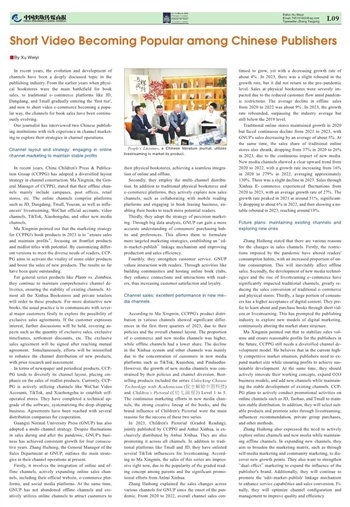■By Xu Weiyi
In recent years, the evolution and development of channels have been a deeply discussed topic in the publishing industry. From the earlier years when physical bookstores were the main battlefield for book sales, to traditional e-commerce platforms like JD, Dangdang, and Tmall gradually entering the 'first tier', and now to short video e-commerce becoming a popular way, the channels for book sales have been continuously evolving.
Our journalist has interviewed two Chinese publishing institutions with rich experience in channel marketing to explore their strategies in channel operations.
Channel layout and strategy: engaging in online channel marketing to maintain stable profits
In recent years, China Children's Press & Publication Group (CCPPG) has adopted a diversified layout strategy in channel construction. Ma Xingmin, the General Manager of CCPPG, stated that their offline channels mainly include campuses, post offices, retail stores, etc. The online channels comprise platforms such as JD, Dangdang, Tmall, Youzan, as well as influencers' livestreaming, WeChat official accounts, video channels, TikTok, Xiaohongshu, and other new media channels.
Ma Xingmin pointed out that the marketing strategy for CCPPG's book products in 2023 is to “ensure sales and maintain profits”, focusing on frontlist products and midlist titles with potential. By customizing different versions to meet the diverse needs of readers, CCPPG aims to activate the vitality of some older products and boost the sales of new products. The results so far have been quite outstanding.
For general series products like Plants vs. Zombies, they continue to maintain comprehensive channel deliveries, ensuring the stability of existing channels. Almost all the Xinhua Bookstores and private retailors will order to these products. For more distinctive new books, the usual practice is to communicate with several major customers firstly to explore the possibility of exclusive sales agreements. If the customer expresses interest, further discussions will be held, covering aspects such as the quantity of exclusive sales, exclusive timeframes, settlement discounts, etc. The exclusive sales agreement will be signed after reaching mutual agreement. Simultaneously, efforts will be intensified to enhance the channel distribution of new products, with prior research and assessment.
In terms of newspaper and periodical products, CCPPG tends to diversify its channel layout, placing emphasis on the sales of midlist products. Currently, CCPPG is actively utilizing channels like WeChat Video Accounts, TikTok, and Xiaohongshu to establish self-operated stores. They have completed a technical upgrade of the software, systematizing the drop-shipping business. Agreements have been reached with several distribution companies for cooperation.
Guangxi Normal University Press (GNUP) has also adopted a multi-channel strategy. Despite fluctuations in sales during and after the pandemic, GNUP's business has achieved consistent growth for four consecutive years. Zhang Haihong, the General Manager of the Sales Department at GNUP, outlines the main strategies in their channel operations at present.
Firstly, it involves the integration of online and offline channels, actively expanding online sales channels, including their official website, e-commerce platforms, and social media platforms. At the same time, GNUP has not abandoned offline channels and creatively utilizes online channels to attract customers to their physical bookstores, achieving a seamless integration of online and offline.
Secondly, they employ the multi-channel distribution. In addition to traditional physical bookstores and e-commerce platforms, they actively explore new sales channels, such as collaborating with mobile reading platforms and engaging in book leasing business, enabling their books to reach more potential readers.
Thirdly, they adopt the strategy of precision marketing. Through big data analysis, GNUP can gain a more accurate understanding of consumers' purchasing habits and preferences. This allows them to formulate more targeted marketing strategies, establishing an “edit-market-publish” linkage mechanism and improving production and sales efficiency.
Fourthly, they strengthen customer service. GNUP values interaction with readers. Through activities like building communities and hosting online book clubs, they enhance connections and interactions with readers, thus increasing customer satisfaction and loyalty.
Channel sales: excellent performance in new media channels
According to Ma Xingmin, CCPPG's product distribution in various channels showed significant differences in the first three quarters of 2023, due to their policies and the overall channel layout. The proportion of e-commerce and new media channels was higher, while offline channels had a lower share. The decline in the Xinhua system and other channels was mainly due to the concentration of customers in new media platforms such as TikTok, Kuaishou, and Pinduoduo. However, the growth of new media channels was constrained by their policies and channel diversion. Best-selling products included the series Unlocking Chinese Technology with Academicians (院士解锁中国科技) and Children's Pictorial (《幼儿画报》) Level 1 to 5. The continuous marketing efforts in new media channels, the strong creative lineup of the books, and the brand influence of Children's Pictorial were the main reasons for the success of these two series.
In 2023, Children's Pictorial (Graded Reading), jointly published by CCPPG and Anhui Xinhua, is exclusively distributed by Anhui Xinhua. They are also promoting it across all channels. In addition to traditional platforms like Tmall and JD, they have enlisted several TikTok influencers for livestreaming. According to Ma Xingmin, the sales of this series are impressive right now, due to the popularity of the graded reading concept among parents and the significant promotional efforts from Anhui Xinhua.
Zhang Haihong explained the sales changes across various channels for GNUP since the onset of the pandemic. From 2020 to 2022, overall channel sales continued to grow, yet with a decreasing growth rate of about 4%. In 2023, there was a slight rebound in the growth rate, but it did not return to the pre-pandemic level. Sales at physical bookstores were severely impacted due to the reduced customer flow amid pandemic restrictions. The average decline in offline sales from 2020 to 2022 was about 9%. In 2023, the growth rate rebounded, surpassing the industry average but still below the 2019 level.
Traditional online stores maintained growth in 2020 but faced continuous decline from 2021 to 2023, with GNUP's sales decreasing by an average of about 5%. At the same time, the sales share of traditional online stores also shrank, dropping from 37% in 2020 to 26% in 2023, due to the continuous impact of new media. New media channels showed a clear upward trend from 2020 to 2022, with a growth rate increasing from 16% in 2020 to 279% in 2022, averaging approximately 130%. There was a slight decline in 2023. Sales through Xinhua E-commerce experienced fluctuations from 2020 to 2023, with an average growth rate of 27%. The growth rate peaked in 2021 at around 51%, significantly dropping to about 6% in 2022, and then showing a notable rebound in 2023, reaching around 18%.
Future plans: maintaining existing channels and exploring new ones
Zhang Haihong stated that there are various reasons for the changes in sales channels. Firstly, the restrictions imposed by the pandemic have altered readers' consumption habits, with an increased proportion of online consumption. This will inevitably affect offline sales. Secondly, the development of new media technologies and the rise of livestreaming e-commerce have significantly impacted traditional channels, greatly reducing the sales conversion of traditional e-commerce and physical stores. Thirdly, a large portion of consumers has a higher acceptance of digital content. They prefer to learn about and purchase books through short videos or livestreaming. This has prompted the publishing industry to explore new models of digital marketing, continuously altering the market share structure.
Ma Xingmin pointed out that to stabilize sales volume and ensure reasonable profits for the publishers in the future, CCPPG still needs a diversified channel development model. He believes that in the current highly competitive market situation, publishers need to expand market size while ensuring profits to achieve sustainable development. At the same time, they should actively innovate their working concepts, expand O2O business models, and add new channels while maintaining the stable development of existing channels. CCPPG plans to actively conduct promotional activities on online channels such as JD, Taobao, and Tmall to maintain stable distribution. In addition, they will select suitable products and promote sales through livestreaming, influencer recommendation, private group purchases, and other methods.
Zhang Haihong also expressed the need to actively explore online channels and new media while maintaining offline channels. In expanding new channels, they aim to broaden the marketing matrix, such as through self-media marketing and community marketing, to discover new growth points. They also want to strengthen “dual-effect” marketing to expand the influence of the publisher's brand. Additionally, they will continue to promote the 'edit-market-publish' linkage mechanism to enhance service capabilities and sales conversion. Finally, they will optimize channel configuration and management to improve quality and efficiency.



